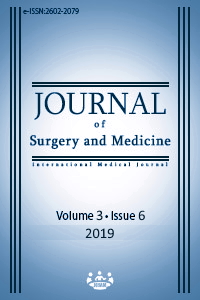Assessment of axillary hyperhidrosis and bromhidrosis treatment with microwave technology
Keywords:
Axillary hyperhidrosis, Axillary bromhidrosis, Microwave technology, Axillary glandsAbstract
Aim: Hyperhidrosis and bromhidrosis are disorders related with generalized or local excessive sweating that can have a significant impact on the quality of life of patients who suffer from them. There are several treatments, both topical and invasive, with permanent or temporary effects. In recent years, microwave technology has emerged as a non-invasive procedure with permanent effects and few side effects. The study aim was to evaluate the efficacy, safety and satisfaction degree of patients with axillary hyperhidrosis and bromhidrosis treatment using microwave technology, and the primary outcome was to increase patient satisfaction about their sweating levels.
Methods: Retrospective cohort study is planned and included the patients underwent a single microwave session with miraWave® technology for hyperhidrosis or bromhidrosis. Efficacy and safety were assessed at one, three, six, and 12 months. Inclusion criteria were men or women between 18-65 years old, diagnosed with hyperhidrosis and an HDSS score of 2-4. Patients with pacemakers and expectant or lactating mothers were excluded. Before treatment, patients were diagnosed using the Hyperhidrosis Disease Severity Scale, and the Minor test. Satisfaction was assessed through a subjective assessment of the satisfaction level, using a questionnaire in which participants chose the sentence that best fitted with an assigned score of 0-10.
Results: A total of 46 patients participated in the study: 20 women (43.48%) and 26 men (56.52%) aged between 18-65 years old. Throughout the follow-up period, an average of 49.88% of patients reported a subjective improvement of hyperhidrosis and 95% reported the same about bromhidrosis. After comparing the results of their previous level of sweating with those after one year of treatment, 80.40% of patients showed themselves satisfied. All side effects were resolved in a time not exceeding 10 weeks.
Conclusion: Microwave technology proves to be an effective and lasting treatment after one single session for axillary hyperhidrosis and/or bromhidrosis.
Downloads
References
Atkins JL, Butler PEM. Hyperhidrosis: A review of current management. Vol. 110, Plastic and Reconstructive Surgery. 2002. p. 222–8. Doi: 10.1097/00006534-200207000-00039.
Haider A, Solish N. Focal hyperhidrosis: Diagnosis and management. Vol. 172, CMAJ. Canadian Medical Association; 2005. p. 69–75. Doi: 10.1503/cmaj.1040708.
Stolman LP. Hyperhidrosis: medical and surgical treatment. Eplasty. 2008 Apr 18;8:e22.
James AG, Austin CJ, Cox DS, Taylor D, Calvert R. Microbiological and biochemical origins of human axillary odour. Vol. 83, FEMS Microbiology Ecology. Oxford University Press; 2013. p. 527–40. Doi: 10.1111/1574-6941.12054.
Strutton DR, Kowalski JW, PharmD, Glaser DA, Stang PE. US prevalence of hyperhidrosis and impact on individuals with axillary hyperhidrosis: Results from a national survey. J Am Acad Dermatol. 2004;51(2):241–8. Doi: 10.1016/j.jaad.2003.12.040.
Hasson NA, Kam CS, Cataldo CK. Toxina botulínica en el tratamiento de la hiperhidrosis focal primaria. Dermatologia Rev Mex. 2014;58(4):331–8.
Kapıcıbaşı HO. Bilateral endoscopic thoracic sympathectomy via single incision for the treatment of palmar and axillar hyperhidrosis. J Surg Med. 2019 May 24;3(5):393–6. Doi: 10.28982/josam.518325.
Jacob CI. Treatment of hyperhidrosis with microwave technology. Semin Cutan Med Surg. 2013;32(1):2-8.
Hong HC, Lupin M, O’Shaughnessy KF. Clinical evaluation of a microwave device for treating axillary hyperhidrosis. Dermatol Surg. 2012 May;38(5):728–35. Doi: 10.1111/j.1524-4725.2012.02375.x.
Glaser DA, Coleman WP, Fan LK, Kaminer MS, Kilmer SL, Nossa R, et al. A randomized, blinded clinical evaluation of a novel microwave device for treating axillary hyperhidrosis: The dermatologic reduction in underarm perspiration study. Dermatologic Surg. 2012;38(2):185–91. Doi: 10.1111/j.1524-4725.2011.02250.x.
Lupin M, Hong HC, O’Shaughnessy KF. Long-term efficacy and quality of life assessment for treatment of axillary hyperhidrosis with a microwave device. Dermatol Surg. 2014;40(7):805–7. Doi: 10.1111/dsu.0000000000000041.
Sánchez-Carpintero I, Martín-Gorgojo A, Ruiz-Rodríguez R. Microwave Treatment for Axillary Hyperhidrosis and Bromhidrosis. Actas Dermosifiliogr. 2017;108(5):418–22. Doi: 10.1016/j.ad.2016.12.011.
Downloads
- 2230 2474
Published
Issue
Section
How to Cite
License
Copyright (c) 2019 Maribel Serrano Coronado, Jaime Tufet Opi
This work is licensed under a Creative Commons Attribution-NonCommercial-NoDerivatives 4.0 International License.
















